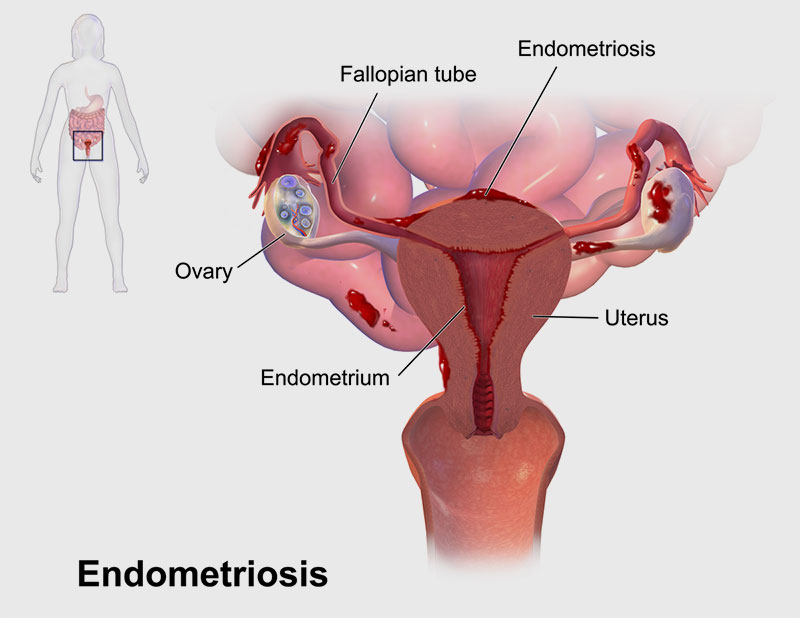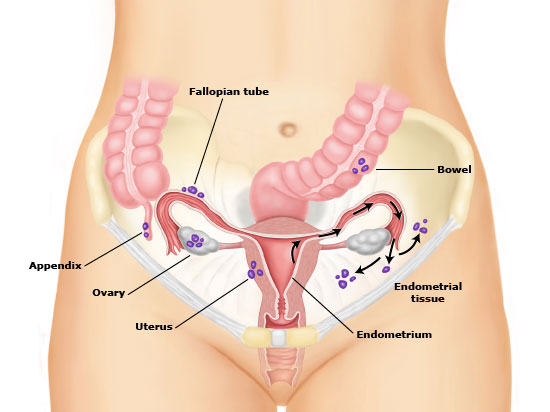Endometrioma is when the tissue lining the inside of the uterus (endometrium) is located somewhere outside the uterus. It occurs in 1 in 10 women of reproductive age. It is usually diagnosed in the 30s to 40s.
What causes endometriosis?
The cause of this disease is unknown. However, one theory is that menstrual blood flows backward with the inner lining of the uterus. This backward tissue grows and develops in these areas. There are other theories, but studies are ongoing in order to resolve the uncertainty.
Where is endometrial tissue most commonly found in the body?
- Ovaries
- Peritoneum
- Tubes
- Bladder, intestines
- Back of the uterus
- Many parts of the body, such as the brain, lungs, lymph nodes (very rare)
What kind of problems does endometriosis cause?
Endometriosis implants respond to the hormone estrogen in women. They grow and bleed, just like the endometrium in the womb. This causes irritation, inflammation and swelling in the surrounding tissue. If the episodes of swelling and bleeding occur every month, over time this leads to adhesions. These adhesions bring the organs closer together and even make them stick together. Thus, bleeding, inflammation and scarring cause pain before and during menstruation.
What is the relationship between endometriosis and infertility?
Endometriosis is present in 40% of patients with infertility. As mentioned earlier, the inflammation caused by endometriosis damages both male sperm and egg. In addition, the adhesions interfere with the movement of the fallopian tubes.
How does endometriosis make itself felt?
The most common symptom is abdominal and groin pain that lasts for a long period of time. This pain is especially pronounced before and during menstruation. The pain also increases during sexual intercourse. If there is bowel involvement, there is severe pain during bowel movements, and if there is bladder involvement, there is severe pain during urination. Some patients may even experience bloody stools and bloody urination. Some patients may experience menstrual irregularities and excessive menstrual bleeding. However, in most patients, endometriosis is gradual and does not cause any symptoms.
How is endometriosis diagnosed?
First of all, endometriosis must be examined by a specialist who is familiar with this disease. A thorough physical/pelvic examination should be performed. However, to say with certainty that the patient has endometriosis, a laparoscopy, a surgical procedure, is required. In some procedures, a piece of suspicious tissue is taken (biopsy) to confirm the diagnosis.
How is endometriosis treated?
Treatment depends on the patient’s symptoms, the extent of the disease and the desire to have children. Endometriosis can be treated with medications or surgery. Painkillers and hormonal preparations (birth control pills, progestogen agents, GnRH agonists) are often used, especially in patients for whom pain is the main concern. These hormonal preparations slow down the progression of the disease. It is not possible to completely eliminate the disease with these medications. Surgical methods can relieve the pain, correct adhesions and restore the anatomy.
Will I be cured with certainty by endometriosis surgery?
After surgery, pain goes away in most patients. However, it is possible that the pain may return in the future. In 40-80% of patients, the pain recurs within 2 years after surgery. The more severe the condition was at the time of the initial surgery, the more likely the pain will return.
Is it necessary to remove the uterus and ovaries?
- If you have tried all treatment methods, but still have very severe symptoms
- If you do not want to have children in the future
- If you want permanent and definitive treatment
This option may be recommended by your doctor as a last resort.
I have endometriosis. I can not have children. What are the treatment options?
You should discuss these options with your doctor, depending on the severity of your condition, your age, and previous treatments.
- Medications to treat infertility
- Vaccination therapy in combination with medications
- Surgery
- IVF (in vitro fertilization )







